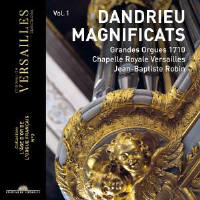Texte paru dans: / Appeared in: Château de Versailles Spectacles |
|
| Enthusiastically recommended. | |
|
Reviewer: James
A. Altena
Despite his renown during his
lifetime, Jean-François Dandrieu (1681/2–1738) has fallen into obscurity.
Born in Paris to a musical family, he was a child prodigy who played the
harpsichord before Louis XIV and the French court at age five. After studies
with Jean-Baptiste Moreau (c. 1656–1733), in 1704 he became the organist of
the Church of Saint-Merri, a position previously held by Nicolas Lebègue (c.
1631–1702), receiving the formal title to the post in 1705. It is likely but
not certain that sometime before 1710 he succeeded his uncle, the
priest/organist/composer Pierre Dandrieu (1664–1733), as organist at St.
Barthélemey as well, under the traditional right of reversion (whereby
French organists in their lifetimes could legally designate their
successors). Musicologists have surmised that relations between uncle and
nephew became strained after Jean-François republished some of Pierre’s
noëls under his own name, since the latter’s will mentions the former’s
siblings but not Jean-François himself. Recognized as one of France’s
leading keyboard virtuosos, in December 1721 Dandrieu was appointed an
organist of the royal chapel. During his lifetime he published several
collections of harpsichord music (for which he was ranked alongside François
Couperin and Rameau), sets of trio sonatas and solo violin sonatas, and a
collection of instrumental works. Upon his death he was buried at St.
Barthélemey, and his sister Jeanne-Françoise succeeded him as organist
there. She also oversaw the posthumous publication of a book of his organ
pieces in 1739.
Recordings devoted to
Dandrieu’s music remain scarce on the ground. I have found only one CD with
an Easter Mass and Vespers service (another Mass was previously issued on
LP, with Marie-Claire Alain as the organist); one with chamber music; four
or five devoted to harpsichord works; one of sacred works for solo voice and
organ; an LP of organ works with Alain and a CD (originally an LP) with
Gillian Weir; and a two-disc set (originally separate releases) of organ and
harpsichord works with André Isoir and Olivier Baumont. Otherwise, isolated
pieces appear in anthology and recital discs. Most of the previous
recordings of Dandrieu’s organ works are of his noëls. There are a few
scattered prior recordings of Magnificats (and some of the shorter works
listed in the headnote), but identification of those is too imprecise for me
to ascertain if they are the same as any of the ones presented here (the
most likely overlap is with Volume 4 in Gillian Weir’s CD series on
Eloquence). Consequently, while they are not specifically identified as
such, this disc presumably presents several premiere recordings. Each Magnificat here consists of five to seven shorter movements which, in line with traditional French practice, are mostly named after featured stops or registrations. Robin’s booklet notes describe Dandrieu’s compositional style as “a synthesis between the Italian fugal and concertante style, the ornamental and dance music of his predecessors and the taste at that time for lightness and elegance.” While there are elements of gravity as well, the ear is immediately drawn to the lively and delightful dance tunes that permeate these scores. The closing track on the disc, the Offertory of the Easter hymn tune “O filii et filiae,” will be immediately familiar to many churchgoers from its adaptation as a congregational hymn by William Monk. Fittingly, the organ utilized here is the 1710 instrument of the Chapel Royal at the Palace of Versailles (the booklet provides several color photos of the eye-popping interior, along with an artist bio, and notes on and specifications for the instrument). It is an absolutely magnificent French Baroque instrument, and the recorded sound is extraordinarily vivid. Above all, Jean-Baptiste Robin is the perfect interpreter for his repertoire, playing with all the verve, imagination, and technical precision one could desire. This is one of the finest French Baroque organ discs I’ve had the pleasure of encountering; and, best of all, it is designated “Volume 1.” I await the sequels with impatience! Enthusiastically recommended.
| |
|
|
|
|
|
|
|
Cliquez l'un ou l'autre
bouton pour découvrir bien d'autres critiques de CD |
|




